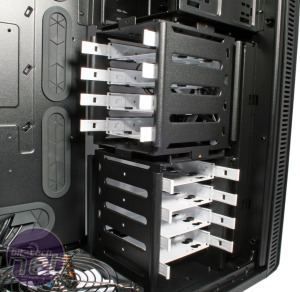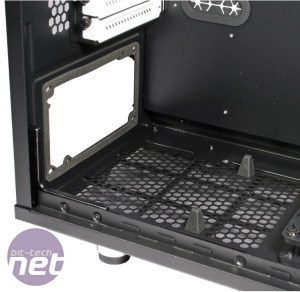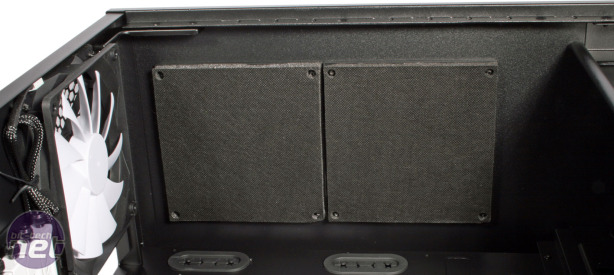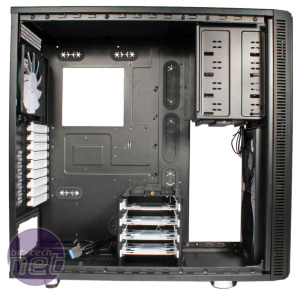
Interior
The side panels utilise thumbscrews and are hinged at the front of the case, which makes getting them on and off even simpler. Removing them, it's apparent just how solid and well constructed they are, as they have a significant weight to them and little flex. Each of them is lined with noise deadening material that's again firmly fixed. The front panel will also come off with a tug, but chances are this won't be necessary as you can access everything you need to just by opening the front door.While the case's exterior is near identical to its predecessor's, the roomy interior has undergone a major redesign, with the biggest change being that it's no longer split into segments. This has apparently been done so as to make water-cooling a more viable option than it previously was: a sensible decision for a large chassis. It leaves the XL R2 with a more traditional layout (no bad thing) and once again there's a huge cutout for CPU cooler backplates.
The PSU area has large anti-vibration rubber spikes and foam padding emphasising Fractal's dedication to quiet computing. Fractal (naturally) recommends its own Newton R3 series of PSUs to complement the Define XL R2, as they are cooled semi-passively and designed to operate with low noise levels, although in our experience the majority of PSUs these days are pretty quiet anyway.


Click to enlarge - The top drive cage can be rotated and the PSU area is designed to soften vibrations
Optical drives slide in from the front and screw into place, an installation procedure we've never really had an issue with. The internal drive bay count has been reduced from ten to eight and divided into two cages of four, the top one of which can be removed entirely or rotated so that it better lines up with airflow from the front fan. Each bay uses a white slide out tray (complete with rubber anti-vibration pads for HDDs), which lock into place securely and can be screwed in too if desired.
The roof can hold both 240mm and 280mm radiators, but there's only 68mm of height to play with. This limits you to slim radiators with fans on just one side, which is pretty disappointing for a case this size. 240mm set-ups might have a little more room beneath them as they rest slightly further to the side of the motherboard area, but this will depend heavily on the motherboard you're using, and even low profile RAM is likely to interfere. This issue could easily have been avoided with offset mounting holes, so it's hard to overlook; even the stubbier Nanoxia Deep Silence 1 can house a full thickness double radiator with fans in its roof area.
As well as 120mm radiator support in the lower fan mount and 140mm support in the rear, you can also mount a water-cooling set-up in the front. The lower drive cage can be unscrewed from the chassis and moved closer to the PSU (as pictured below), thus blocking the bottom fan mount but freeing up the front area. Though 280mm radiators are too tall for the front mounts, the 140mm of depth afforded by moving the drive cage as stated means there's easily enough room for a full thickness 240mm radiator with fans on either side.
As for cable management, there are four main routing holes and three smaller ones (one below the motherboard and two above it), and all are covered by firmly attached yet flexible rubber grommets. Wider form factor motherboards will block a lot of these out, however, which would make the task trickier. Extras that are seen in more premium cases like a pre-attached fan controller and an 8-pin EPS extender aren't to be found, but Fractal does do some routing for you. Several zip ties and hooks as well as lots of space behind the motherboard tray mean that tidying cables away is a trouble free task, and we had no issue closing the side panel either.

MSI MPG Velox 100R Chassis Review
October 14 2021 | 15:04













Want to comment? Please log in.